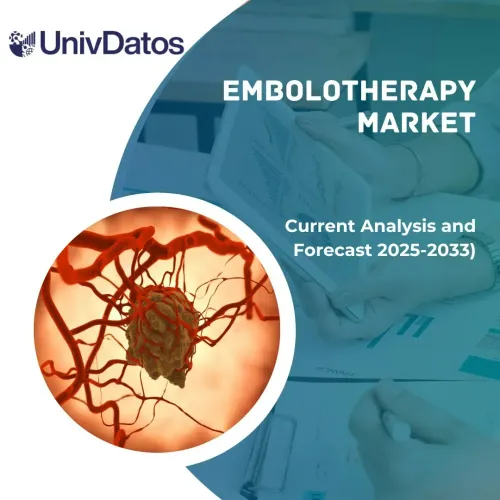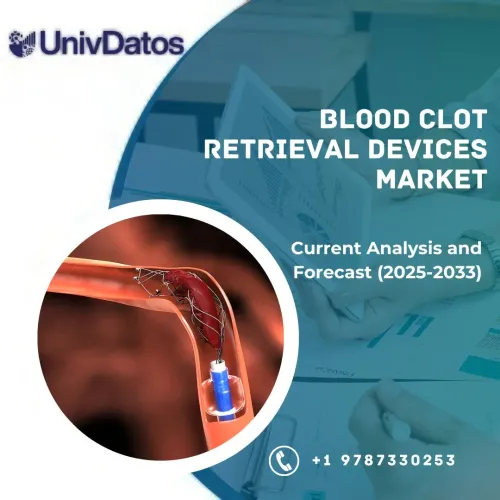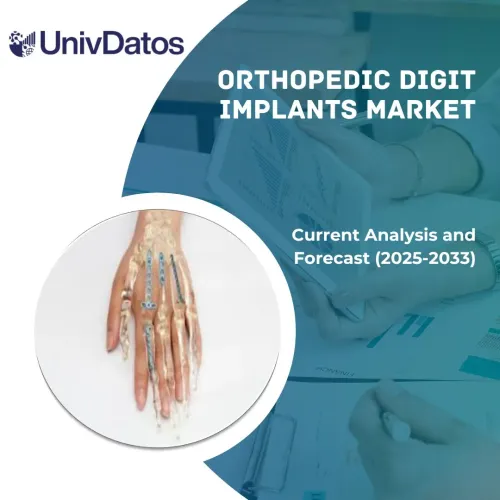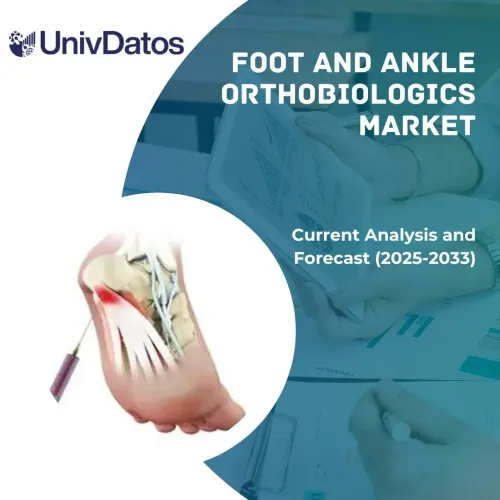- Home
- About Us
- Industry
- Services
- Reading
- Contact Us
Orthopedic Digit Implants Market: Current Analysis and Forecast (2025-2033)
Emphasis on Product (Metatarsal Joint Implants, Metacarpal Joint Implants, Toe Intramedullary Digit Implants, Scaphoid Bone Digit Implants, and Hemi-Phalangeal Digit Implants); Material (Pyrocarbon, Titanium, Nitinol, and Others); End-User (Hospitals, Clinics, and Others); and Region/Country
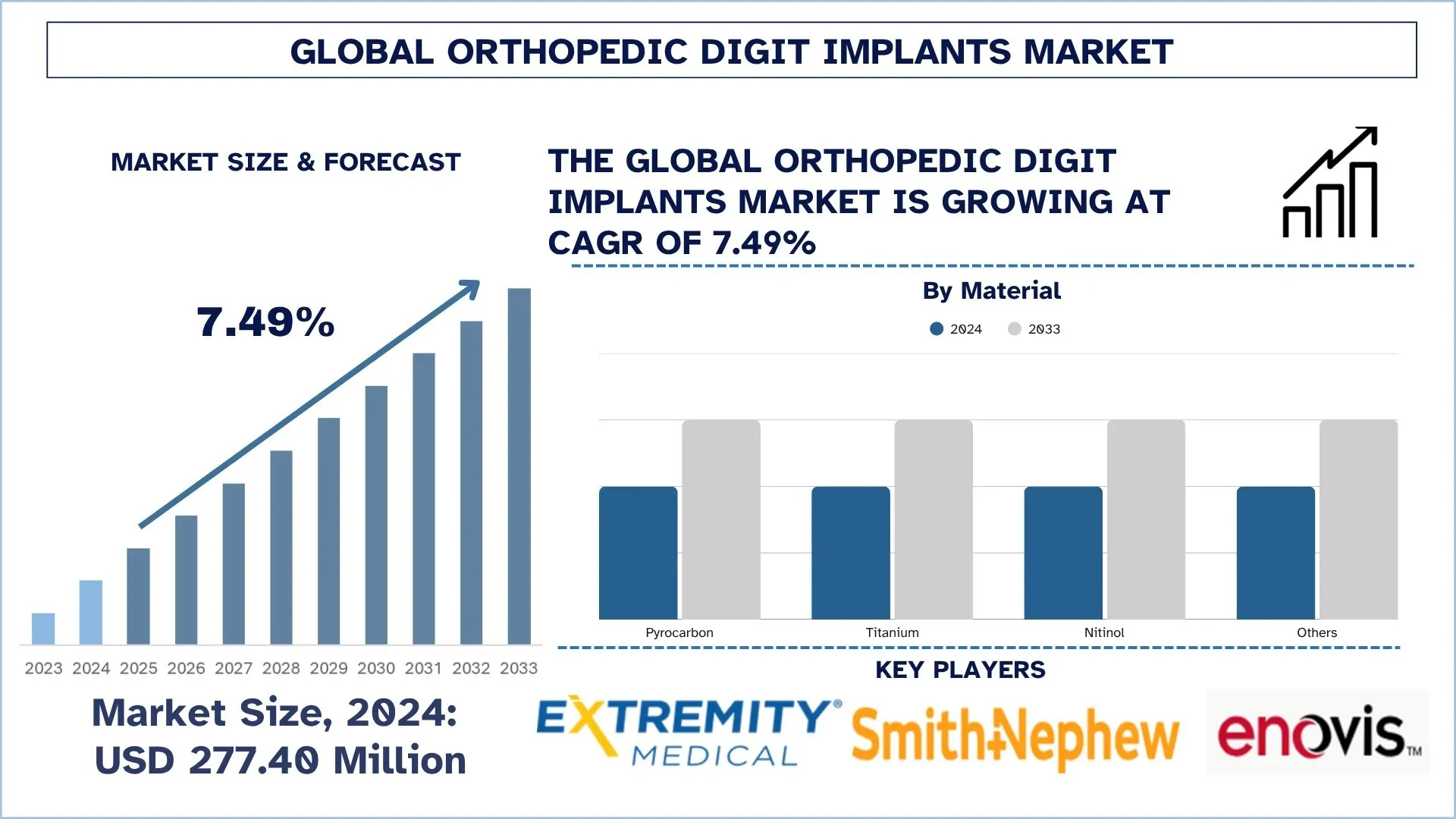
Global Orthopedic Digit Implants Market Size & Forecast
The global orthopedic digit implants market was valued at USD 277.40 million in 2024 and is expected to grow at a strong CAGR of 7.49% during the forecast period (2025-2033F), driven by the increasing incidence of degenerative and traumatic conditions, technological advancements in implant materials, and the adoption of minimally invasive procedures.
Orthopedic Digit Implants Market Analysis
Orthopedic digit implants are the medical devices that are used to support bones and joints in the fingers and toes to restore their articular mobility, reduce pain, and improve overall quality of life for patients. The global demand for advanced and biocompatible materials in the healthcare and medical device industry is driving the growth of the orthopedic digit implants market. This is due to the increasing incidence of musculoskeletal disorders, such as osteoarthritis, trauma, and deformities in fingers and toes, which is increasing the demand for implant solutions. Additionally, the increasing awareness about minimally invasive surgeries for substantial and long-lasting implants is boosting market growth. Moreover, growing technological advancements in implant materials and government support for healthcare infrastructure and surgical, are further accelerating the growth of the market.

Global Orthopedic Digit Implants Market Trends
This section discusses the key market trends that are influencing the various segments of the global orthopedic digit implants market, as found by our team of research experts.
Increasing Adoption of 3D Printing Technology
The increasing adoption of 3D printing technology is one of the prominent key trends in the orthopedic digit implants market. Unlike traditional production methods, which often face limitations in designing anatomically fitted implants, 3D printing provides the creation of customized, patient-specific implants, thereby enhancing surgical accuracy and functional results. This technology enables the production of complex geometries and porous structures that enhance osseointegration, ensuring better bonding between the implant and the natural bone. Additionally, for manufacturing lightweight and durable implants, advanced osseointegrated materials such as titanium and biopolymers are used in 3D printing. The tailored solution provided by 3D printing minimizes the need for significant intraoperative modification, reducing recovery time and improving patient safety. For example, in 2025, NIH researchers revealed the effectiveness of 3D-printed customized prostheses for treating traumatic metacarpophalangeal (MCP) joint defects. The research highlights the anatomical accuracy offered by implants for individual patients. The study shows 3D printing as a transformative technology in orthopedic digit implants, offering a patient-specific, efficient, and reliable alternative to traditional implant methods. Therefore, 3D printing is set to change the orthopedic digit implants market by offering customized and accurate solutions, improving surgical results, and minimizing recovery time.
Orthopedic Digit Implants Industry Segmentation
This section provides an analysis of the key trends in each segment of the global orthopedic digit implants market report, along with forecasts at the global, regional, and country levels for 2025-2033.
The Metatarsal Joint Implants Segment Dominates the Global Orthopedic Digit Implants Market
Based on the product category, the market is categorized into metatarsal joint implants, metacarpal joint implants, toe intramedullary digit implants, scaphoid bone digit implants, and hemi-phalangeal digit implants. The metatarsal joint implants segment dominated the orthopedic digit implants market due to clinical and demographic factors. One of the primary drivers is the widespread occurrence of foot disorders, including hallux rigidus, osteoarthritis, and traumatic injuries that affect the metatarsophalangeal joints. These conditions are especially common among older and active adult populations, thereby boosting the demand for surgical interventions.
The Titanium Segment Dominates the Global Orthopedic Digit Implants Market.
Based on the material category, the market is categorized into pyrocarbon, titanium, nitinol, and others. Among these, the titanium segment dominates the market due to its robustness, biocompatibility, and performance. One of the main reasons for its large-scale utilization is its high strength-to-weight ratio, which means that implants are long-lasting and lightweight, minimizing stress around the surrounding bones and tissues. Additionally, titanium is resistant to corrosion, therefore reducing the risk of inflammation and implant rejection. Furthermore, it allows bones to grow and fuse with implants naturally, thereby ensuring faster recovery.
North America holds the largest market share in the global orthopedic digit implants market
North America holds the largest market share in the global orthopedic digit implants market since it has a well-established healthcare infrastructure, rising cases of osteoarthritis, early adoption of advanced technologies such as 3D printing, along with strong government support, and healthcare policies. Additionally, the region is home to specialized orthopedic centers, which are capable of handling complicated digit implant surgeries, supported by skilled doctors and medical staff. The growing elderly population and increased cases of osteoarthritis, rheumatoid arthritis, and traumatic finger and toe injuries have rapidly increased the demand for digit implants. Moreover, continuous research and development activities in the region, coupled with strategic investments, have resulted in the creation of advanced implant materials, designs, and surgical techniques, thereby driving market growth. For instance, in 2024, Restor3D raised a USD 70 million fund to improve its 3D-printed customized digit implants, highlighting the growing focus on innovation.
The U.S. held a Dominant share of the North America Orthopedic Digit Implants Market in 2024
The U.S. dominated the North America global orthopedic digit implants market due to its well-established healthcare infrastructure, early adoption of advanced technologies, strong FDA framework, and government support. A large number of people in the U.S. suffer from musculoskeletal conditions, such as osteoarthritis, rheumatoid arthritis, and traumatic finger and toe injuries, which drives the demand for digit implant procedures. According to the Arthritis Foundation, in 2024, nearly 1.5 million people in the US suffer from rheumatoid arthritis, which causes the degradation and joint deformation of fingers and toes, therefore, directly driving the demand for orthopedic digit implants. Furthermore, due to the country's broad health insurance and expansive coverage policies, patients can afford advanced orthopedic surgeries. Moreover, the country is home to leading global orthopedic implant companies, such as Stryker, Zimmer Biomet, and Acumed, which encourage product innovation, strategic partnerships, and clinical trials in the U.S., further consolidating market dominance.

Orthopedic Digit Implants Industry Competitive Landscape
The global orthopedic digit implants market is competitive, with several global and international market players. The key players are adopting different growth strategies to enhance their market presence, such as partnerships, agreements, collaborations, geographical expansions, and mergers and acquisitions.
Top Orthopedic Digit Implants Market Companies
Some of the major players in the market are Extremity Medical, LLC, Smith & Nephew, Enovis Corporation, Neosys, Medartis, Arthrex, Inc., Acumed LLC (Marmon Holdings, Inc.), Stryker, BioPro, Inc., and Wuxi Keenman Manufacturing Technology Co., Ltd.
Recent Developments in the Orthopedic Digit Implants Market
In February 2024, Anatomic Implants, in collaboration with AddUp, announced the submission of a 510(k) application to the U.S. Food and Drug Administration (FDA) for the world's first 3D-printed toe joint replacement. This innovative implant, designed for the first metatarsophalangeal (MTP) joint, aims to address the underserved market for MTP joint reconstruction, particularly for patients with osteoarthritis.
In August 2024, Tyber Medical announced that its PEEK ToeGrip hammer toe implant family had received MDR (Medical Device Regulation) certification, marking a significant milestone in its European regulatory compliance. Designed to treat hammer toe deformities, the PEEK ToeGrip implants leverage biocompatible polymer technology to improve patient outcomes and enhance post-surgical recovery. This regulatory achievement positions Tyber Medical to expand its presence in the European orthopedic market and underscores the company’s commitment to innovative, patient-centered foot and ankle solutions.
Global Orthopedic Digit Implant Market Report Coverage
Report Attribute | Details |
Base year | 2024 |
Forecast period | 2025-2033 |
Growth momentum | Accelerate at a CAGR of 7.49% |
Market size 2024 | USD 277.40 million |
Regional analysis | North America, Europe, APAC, Rest of the World |
Major contributing region | The Asia-Pacific region is expected to dominate the market during the forecast period. |
Key countries covered | U.S., Canada, Germany, U.K., Spain, Italy, France, China, Japan, India, and South Korea. |
Companies profiled | Extremity Medical, LLC, Smith & Nephew, Enovis Corporation, Neosys, Medartis, Arthrex, Inc., Acumed LLC (Marmon Holdings, Inc.), Stryker, BioPro, Inc. and Wuxi Keenman Manufacturing Technology Co., Ltd. |
Report Scope | Market Trends, Drivers, and Restraints; Revenue Estimation and Forecast; Segmentation Analysis; Demand and Supply Side Analysis; Competitive Landscape; Company Profiling |
Segments Covered | By Product, By Material, By End-User, and By Region/Country |
Reasons to Buy the Orthopedic Digit Implants Market Report:
The study includes market sizing and forecasting analysis confirmed by authenticated key industry experts.
The report briefly reviews overall industry performance at a glance.
The report covers an in-depth analysis of prominent industry peers, primarily focusing on key business financials, type portfolios, expansion strategies, and recent developments.
Detailed examination of drivers, restraints, key trends, and opportunities prevailing in the industry.
The study comprehensively covers the market across different segments.
Deep dive regional level analysis of the industry.
Customization Options:
The global Orthopedic digit implants market can further be customized as per the requirements or any other market segment. Besides this, UnivDatos understands that you may have your own business needs; hence, feel free to contact us to get a report that completely suits your requirements.
Table of Content
Research Methodology for the Global Orthopedic Digit Implants Market Analysis (2023-2033)
We analyzed the historical market, estimated the current market, and forecasted the future market of the global orthopedic digit implants market to assess its application in major regions worldwide. We conducted exhaustive secondary research to gather historical market data and estimate the current market size. To validate these insights, we carefully reviewed numerous findings and assumptions. Additionally, we conducted in-depth primary interviews with industry experts across the orthopedic digit implants value chain. After validating market figures through these interviews, we used both top-down and bottom-up approaches to forecast the overall market size. We then employed market breakdown and data triangulation methods to estimate and analyze the market size of industry segments and sub-segments.
Market Engineering
We employed the data triangulation technique to finalize the overall market estimation and derive precise statistical numbers for each segment and sub-segment of the global orthopedic digit implants market. We split the data into several segments and sub-segments by analyzing various parameters and trends, including product, material, end-user, and regions within the global orthopedic digit implants market.
The Main Objective of the Global Orthopedic Digit Implants Market Study
The study identifies current and future trends in the global orthopedic digit implants market, providing strategic insights for investors. It highlights regional market attractiveness, enabling industry participants to tap into untapped markets and gain a first-mover advantage. Other quantitative goals of the studies include:
Market Size Analysis: Assess the current and forecast market size of the global orthopedic digit implants market and its segments in terms of value (USD).
Orthopedic Digit Implants Market Segmentation: Segments in the study include areas of product, material, end-user, and region.
Regulatory Framework & Value Chain Analysis: Examine the regulatory framework, value chain, customer behavior, and competitive landscape of the orthopedic digit implants industry.
Regional Analysis: Conduct a detailed regional analysis for key areas such as Asia Pacific, Europe, North America, and the Rest of the World.
Company Profiles & Growth Strategies: Company profiles of the Orthopedic digit implants market and the growth strategies adopted by the market players to sustain the fast-growing market.
Frequently Asked Questions FAQs
Q1: What is the global orthopedic digit implants market’s current market size and growth potential?
In 2024, the global orthopedic digit implants market is valued at approximately USD 277.40 million. It is expected to grow at a CAGR of 7.49% from 2025 to 2033, driven by rising demand for finger and toe joint implants, advancements in surgical technologies, and increasing prevalence of degenerative and traumatic conditions.
Q2: Which segment has the largest share of the global orthopedic digit implants market by product category?
The metatarsal Joint Implants segment accounts for the largest share of the global orthopedic digit implants market due to high adoption in toe joint replacement surgeries and growing awareness among surgeons.
Q3: What are the driving factors for the growth of the global orthopedic digit implants market?
Top growth drivers of the orthopedic digit implants market include:
• Rising incidence of degenerative and traumatic hand and foot conditions
• Rapid technological advancements in implant design and materials
• Growing preference for minimally invasive digit surgeries.
Q4: What are the emerging technologies and trends in the global orthopedic digit implants market?
Emerging trends in the orthopedic digit implants market include:
• Increasing use of biodegradable digit joint implants
• Adoption of 3D printing technology for patient-specific implants
• Integration of innovative surgical techniques for faster recovery.
Q5: What are the key challenges in the global orthopedic digit implants market?
Key challenges in the orthopedic digit implants market include:
• High costs of procedures and implants
• Risk of post-surgery complications, including infection or implant failure.
Q6: Which region dominates the global orthopedic digit implants market?
North America dominates the global orthopedic digit implants market.
Q7: Who are the key competitors in the global orthopedic digit implants market?
Top players in the orthopedic digit implants industry include:
• Extremity Medical, LLC
• Smith & Nephew
• Enovis Corporation
• Neosys
• Medartis
• Arthrex, Inc.
• Acumed LLC (Marmon Holdings, Inc.)
• Stryker
• BioPro, Inc.
• Wuxi Keenman Manufacturing Technology Co., Ltd.
Q8: What are the investment and growth opportunities in the orthopedic digit implants market?
Investors and businesses can explore opportunities in emerging markets, customized implant solutions, 3D-printed digit implants, and biodegradable materials, driven by increasing patient demand and technological advancements.
Q9: How is technological innovation shaping the future of the orthopedic digit implants industry?
Technological innovations, including 3D printing, patient-specific implants, biodegradable materials, and digital surgical navigation systems, are transforming the industry. These advancements enable improved surgical outcomes, faster recovery, and personalized treatment solutions, creating a significant growth trajectory for the market.
Related Reports
Customers who bought this item also bought



